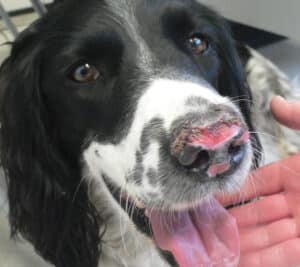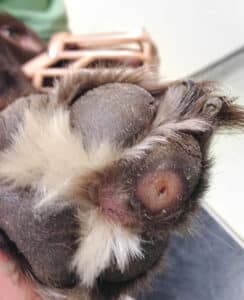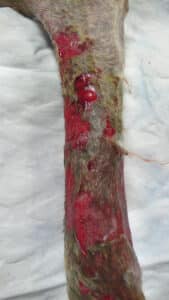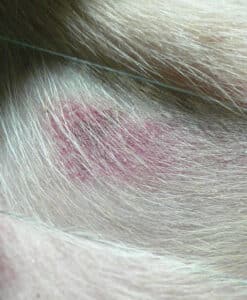What is cutaneous vasculitis?
Cutaneous vasculitis is a term used to describe a variety of skin diseases that are caused when inflammation targets the blood vessel walls. In dogs and cats, inflammation tends to affect the small blood vessels of the skin. Vasculitis is not a diagnosis in its own right, as it can be associated with a number of different causes.
Why causes vasculitis?
The inflammation is thought to be the result of an abnormal immune response. This abnormal response can be triggered by a number of different things. Many drugs have been implicated in the formation of vasculitis, and a thorough drug history is therefore vital in animals where vasculitis is suspected. Vaccines can also be responsible for many cases of vasculitis. In particular, a characteristic presentation of vasculitis has been reported following the administration of rabies vaccinations, however it is normally a mild reaction with some hair loss. Various infections including bacteria, viruses and protozoa (single celled organisms) have also been implicated in cases of vasculitis and rare cases can be triggered by internal cancer. Additionally, a subset of cases do not have an identifiable trigger and are termed ‘idiopathic’.
Genetics may well have a part to play in the development of cutaneous vasculitis. In dogs, breeds such as the German Shepherd Dog, Saint Bernard, Jack Russell Terrier, Greyhound and the Chinese Shar Pei appear particularly prone to vasculitis. Breeds such as the Yorkshire Terrier, Poodle, Silky Terrier and the Maltese Terrier appear to be more prone to develop vasculitis as a result of vaccination.
What effects does vasculitis have on dogs and cats?
Lesions of vasculitis are usually limited to the skin in dogs and cats, but other internal organs may be affected in rare cases. Clinical signs usually develop at sites such as the ear tips, nose, lips, tail, inside the mouth and at sites on the paws like the footpads and claws. Lesions also often occur over boney prominences such as the elbows and hocks.
When vasculitis is severe and when it occurs suddenly, inflammation results in bleeding and interruption to the blood supply to the skin. Affected animals present with bruising (bleeding into the skin), blisters and ulcers (Figures 1, 2 and 3), and animals are frequently depressed and in pain. In milder cases, where disruption to the blood supply occurs more slowly, clinical signs include hair loss, scaling, plugged follicles (‘black heads’) and scarring.

Figure 1 Ulcerative lesions on the nose of a dog with cutaneous vasculitis

Figure 2 Circular area of depigmentation and ulceration on the footpad of a dog with cutaneous vasculitis

Figure 3 Severe ulcers on the leg of a Greyhound with cutaneous vasculitis
There are also a number of unique presentations of vascular disease in dogs and cats. An ulcerative form of vasculitis has been described affecting a small number of Saint Bernard dogs limited to the philtrum of the nose (the area between the nostrils). In Greyhounds, a particularly severe form of vasculitis has been reported resulting in ulcerative skin lesions starting on the limbs and often occurring in conjunction with life-threatening kidney disease. Additionally, vasculitis is responsible for a syndrome seen in young German Shepherd puppies resulting in swollen, painful and depigmented footpads.
How is cutaneous vasculitis diagnosed?
A strong suspicion of a vascular disorder can be obtained from the animal’s history and following close inspection of the animal’s clinical signs. Areas of cutaneous bleeding can be confirmed by applying pressure to the lesions with a glass slide or cup to demonstrate that the colour does not disappear with pressure (Figure 4).

Figure 4 Bleeding into the skin from vasculitis does not fade with pressure from a microscope slide
However, biopsies of the affected skin are usually required to reach a firm diagnosis. Careful selection of biopsy sites is imperative to maximise the chances of obtaining the diagnosis. This is because the characteristic signs of vasculitis can be very subtle and often transient, and pathologists have difficulty in reaching the diagnosis if these signs are not seen.
How is cutaneous vasculitis treated?
The most effective management for cutaneous vasculitis is to identify the underlying cause and correct it. However, once the abnormal immune response has been stimulated, removal of the initial trigger may not be enough on its own.
Drugs to reduce the abnormal immune response are therefore needed in the vast majority of cases, especially in those (idiopathic) cases where no inciting trigger is found. The types of drugs needed depend largely on the severity of skin lesions present and whether there are any signs of internal organ involvement. In milder cases of vasculitis, mild anti-inflammatory drugs can often be used to control the disease. Where ulcers and bleeding lesions are present, more powerful immunosuppressive medications are usually needed.
Unless an obvious underlying cause can be identified and corrected, the vast majority of dogs require long term medications for the rest of their lives. However, despite this, the prognosis for the majority of cases is usually very good.
If you have any queries or concerns, please do not hesitate to contact us.
Arranging a referral for your pet
If you would like to refer your pet to see one of our Specialists please visit our Arranging a Referral page.